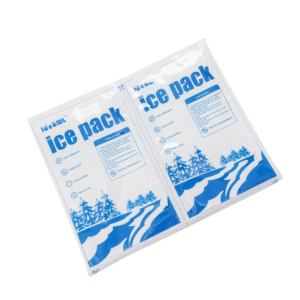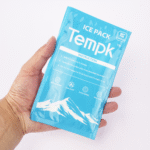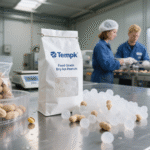Updated August 2025. Large dry ice packs help you ship frozen and ultra‑cold goods with confidence by extending hold time to 24–72 hours while simplifying handling and documentation. En esta guía, you’ll get a practical calculator, compliant pack‑outs, and decision tools you can use today to reduce temperature excursions and cost. Built for cold‑chain shippers in food, farmacéutico, biotecnología, and horticulture.
-
What are large dry ice packs and which type fits your route and temp band? (PCM vs. Co₂)
-
How many packs do you need for 24–72 hours? (simple formula + table)
-
How to pack for compliance and fewer excursions? (step‑by‑step)
-
When do hazmat rules apply and when they don’t? (UN1845, Clase 9 overview)
-
What’s new in 2025 and how does it help you? (sostenibilidad, sensors, better PCM)
What are large dry ice packs and which type should you choose?
Respuesta corta: “Large dry ice packs” are either (1) reutilizable PCM packs that freeze below 0 °C for safe, long‑lasting cold, o (2) CO₂ dry ice blocks/slabs (UN1845) for extreme cold (down to −78.5 °C). Pick PCM large dry ice packs for most frozen shipments (−20 °C to 0 °C); choose CO₂ blocks for ultra‑cold or very long routes. The right choice cuts paperwork, hazards, and cost.
Why it matters to you: In everyday cold chain, PCM large dry ice packs deliver sub‑zero control without CO₂ gas or hazmat limits. Use CO₂ only when you truly need ultra‑low temps (p.ej., ≤−50 °C) or very long transit beyond 72 horas. That split lets you optimize safety, tiempo, and unit economics.
How many large dry ice packs do you need for 24–72 hours?
Deep dive: Capacity depends on transit hours, aislamiento, ambient heat, and product mass. For CO₂ dry ice, a practical estimate is 5–10 lb per 24 h in standard insulation; VIP lowers the rate. For PCM large dry ice packs, plan by surface coverage and total PCM mass; pre‑chilled cargo reduces load dramatically. Always confirm with a data logger on your first live runs.
Calculadora rápida (rule‑of‑thumb):
| Shipment scenario | Target temp | Typical duration | Starting point | What this means for you |
|---|---|---|---|---|
| Alimentos congelados (−18 °C) | ≤−18 °C | 24–48 h | Line box with large dry ice packs (PCM, −20 °C), top‑load extra sheet | Achieve frozen hold without hazmat process. |
| Ultra‑cold biologics | ≤−50 °C | 48–96 h | CO₂ dry ice blocks around payload; vented box | Extreme cold + Clase 9 labeling required. |
| Plants in summer lanes | 2–10 °C | 24–48 h | PCM packs (0–5 °C) side + arriba, add spacer | Avoid freeze injury; no CO₂ gas in box. |
| Vacunas (2–8 °C) | 2–8 °C | 24–72 h | PCM +5 °C panels + data logger | Stable range for audits; no hazmat. |
| Scenarios consolidated from the three draft articles and field practice. |
Practical tips with large dry ice packs
-
Pre‑condition everything: Pre‑freeze or pre‑chill products so packs maintain, not create, the cold.
-
Top‑load cold: Cold sinks; put large dry ice packs on top and around sides for even gradients.
-
Freeze fully: Freeze PCM packs flat ≥8 hours at −18 °C; no slushy cores. Rehydrate dehydrated sheets before reuse.
Field case: A lab shipped vaccines cross‑country in summer using PCM large dry ice packs at +5 °C inside a VIP shipper; the box stayed near 5 °C for ~36 h despite >30 °C ambient, with no hazmat paperwork.
How do you pack with large dry ice packs to cut excursions?
Respuesta corta: Pre‑cool, insulate, position, vent (if CO₂), and label. Large dry ice packs (PCM) go around and above products in a tight, insulated cavity; CO₂ requires vent paths and UN1845 labeling. A tidy pack‑out = longer hold + safer handling.
Step‑by‑step (applies every time):
-
Pre‑cool the shipper (EPS or VIP) and the product.
-
Stage your packs: freeze PCM large dry ice packs sólido; for CO₂, break slabs to fit.
-
Build a cocoon: side‑line → base → product → top‑load extra packs.
-
Seal well: reduce air gaps; add void‑fill.
-
Instrumentation: place a data logger near the warmest spot (door/top).
-
Cumplimiento: vent if CO₂, apply UN1845/Class 9 + net weight; PCM needs no hazmat labels.
Large dry ice packs VS. CO₂ dry ice vs. paquetes de gel
| Criterion | Large dry ice packs (PCM) | CO₂ dry ice (UN1845) | Regular gel packs | What it means |
|---|---|---|---|---|
| Temperatura | ~−20 °C to +5 °C set points | Down to −78.5 °C | ~0 °C | Pick PCM for most frozen/chilled; CO₂ for ultra‑cold. |
| Duración | 24–72 h (with VIP) | 2–5+ days (enough mass) | 6–12 h | PCM covers most e‑commerce/overnight routes. |
| Hazmat | None | Clase 9; vent + etiquetas | None | PCM simplifies ops and training. |
| Reutilizabilidad | Alto (dozens of cycles) | Single‑use (Susilimaciones) | Reutilizable | Lower lifetime cost with PCM. |
| Comparison refined from all three drafts. |
Actionable pointers
-
Pharma 2–8 °C: Use +5 °C PCM large dry ice packs with VIP; add a logger and shock indicator.
-
Frozen seafood: Use −20 °C PCM; double‑top‑load for 36–48 h or add a small CO₂ layer for >48 h.
-
Live plants: Use +5–10 °C PCM; evitar el contacto directo; do not use CO₂ in sealed plant boxes.
Real‑world note: One shipper lost a CO₂ shipment due to no vent path; pressure rose and the package failed. After adding venting and labels, incidents dropped to zero.
Regulations: when do hazmat rules apply to large dry ice packs?
Respuesta corta: Only CO₂ “dry ice” is regulated (UN1845, Clase 9). Large dry ice packs that use PCM are not hazmat and need no UN number or special labels. When you ship CO₂ by air or ground, you must vent, mark UN1845 + net weight (kilos), and follow carrier limits.
Compliance checklist (CO₂ only):
-
UN1845 + Clase 9 label on each package and net dry ice weight (kilos).
-
Vented packaging so CO₂ can escape (no airtight containers).
-
Carrier rules (p.ej., airline package limits, often ≤200 kg per piece).
-
Docs as required (p.ej., Shipper’s Declaration where applicable).
For PCM large dry ice packs, none of the above hazmat steps are required.
2025 developments and trends in large dry ice packs
What’s new this year: Shippers are replacing one‑and‑done CO₂ with reusable large dry ice packs + better insulation. Expect eco‑friendly materials, smarter sensors with live alerts, y more precise PCM (tight hold at −20 °C or +5 °C) that extends duration without adding mass. These upgrades improve audit readiness and reduce total landed cost across hot lanes.
At‑a‑glance
-
Greener builds: Recyclable films and reusable designs reduce waste per shipment.
-
Live monitoring: Real‑time temp/humidity alerts reduce investigation time after delivery.
-
Better PCMs: Longer plateaus mean fewer large dry ice packs for the same route time.
Market insight: Growth in e‑grocery and biologics is expanding validated pack‑out libraries and making higher‑grade insulation more affordable, so you can standardize SKUs and train teams faster.
Preguntas frecuentes
Q1: How long do large dry ice packs last?
Típicamente 24–48 h in EPS and up to 72 h in VIP, depending on pack mass, ambient heat, and pre‑conditioning. Always validate with a logger on your first route.
Q2: Are large dry ice packs reusable?
Sí. Quality PCM packs are built for dozens of cycles. Rehydrate dehydrated sheets, inspect seals, and refreeze flat for full performance.
Q3: Do I need hazmat labels?
Only for CO₂ dry ice. PCM large dry ice packs are non‑hazmat and don’t require UN1845 or venting.
Q4: Are large dry ice packs safe for shipping plants?
Yes—use +5–10 °C PCM and avoid direct contact to prevent chill shock; do not use CO₂ in sealed plant boxes.
Q5: How many packs should I start with?
Line the box (all sides + arriba) con large dry ice packs, then add 25–50% more for >48 h or hot lanes. Validate and tune from data.
Resumen & recommendations
Key takeaways: Usar large dry ice packs (PCM) for most frozen/chilled lanes; reserve CO₂ for ultra‑cold or very long routes. Pre‑condition, fully freeze, line all sides, and top‑load extra packs. Validate with a logger and standardize your pack‑out per SKU and lane. You’ll reduce excursions, training overhead, and total cost.
Siguientes pasos (do this now):
-
Pick your type: PCM large dry ice packs (−20 °C or +5 °C) VS. CO₂ based on target temp and duration.
-
Modelo + validate: Use the quick calculator; run a monitored pilot.
-
Standardize: Create lane‑specific SOPs and pack‑out diagrams; train the team.
-
CTA: Request a pack‑out consultation and sample kit from Tempk.
Acerca de Tempk
We design and validate temperature‑controlled packaging—large dry ice packs, paquetes de gel, VIP/EPS shippers, and turnkey kits—for food, farmacéutico, biotecnología, and horticulture. Our focus: reliable hold times, simple SOPs, and measurable savings. Ask us about reusable options and data‑driven pack‑outs that fit your lanes.
CTA: Talk to a Tempk specialist for a tailored pack‑out plan
























